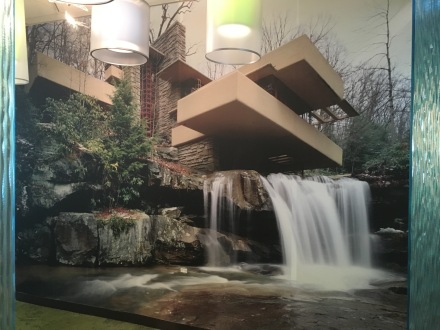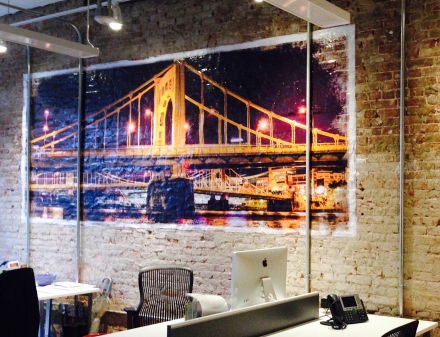AlphaGraphics in the Cultural District
814 Penn Avenue
Pittsburgh, PA 15222
agPittsburgh.com
412-261-1300
Author: agpittsburgh
Company Culture and the Satisfied Customer
by Anne Flanagan

“Culture eats strategy for breakfast.”
This philosophic gem is from Peter Drucker, celebrated business management guru, educator, and author.
Within our company, culture is paramount. From leadership and sales, to marketing and design, production, and accounting, we strive to be a high performing team aligned with our company vision. One that’s inspired, engaged, motivated, and committed to providing clients with great work and an excellent experience.
As a way of measuring this commitment, we survey our clients on a quarterly basis. In our most recent Customer Experience Survey, we asked our clients to tell us how they feel about the quality of our products and services, and how well we meet and exceed their expectations with value-add services that go above and beyond.
We want to know, are they delighted? Satisfied? Disappointed? And more importantly, we ask, how can we do better?
In a culture of high performance, this knowledge is critically important.
Having high customer satisfaction equates to business results. It means the ability to grow revenue and grow the business: staff, facility, tools, technology, and R&D.
Further, research shows that a well-substantiated relationship exists between positive customer experience and employee engagement—the extent to which employees are committed, believe in the vision and values of the company, feel pride in working for their employer, and are motivated to go the extra mile.
According to one study, engaged employees have productivity rates that are 70% higher than those who are not; there is 70% less turnover; and their companies are 44% more profitable.
So, how do we build employee engagement?
Instill a sense of purpose.
A 2016 Gallup poll report notes that companies with high employee engagement use “mission and purpose” as powerful motivators.
A Calling Brands study shows that 65% of employees said a “higher purpose” would motivate them to go the extra mile. Employees defined “purpose” as something beyond the typical mission statement. They felt a sense of purpose if they saw their work had a positive impact on an individual, their company, their community, and/or society.
We must tell our company stories. Stories from employees about great customer experiences they’ve been a part of. Stories that laude employees who go above and beyond as the everyday heroes of superb customer experience.
At a recent team meeting, I asked my coworkers to share a story about a great customer experience they’ve had. Each told about how something they did for a client—however small it seemed at the time—elevated how that client felt about the project, and indeed, about AlphaGraphics.
Voicing and hearing these “hero” stories made our team feel proud and made us contemplate our sense of purpose.
Culture eats strategy for breakfast.
Remember your company’s vision and build strong culture by shining a spotlight on the everyday ways employees internalize that vision in their actions with coworkers and customers.
Share the good stories. Celebrate the everyday heroes. And watch the employee engagement/customer satisfaction relationship soar.
The One 2017 Office Design Trend Everyone Can Adopt
by Anne Flanagan

The way we work is ever evolving.
Today’s structure, content, and process of work is increasingly team-based and collaborative, lean and agile, and technology driven.
And the work environment has evolved in response.
Witness the open concept office, a reflection of this modern-day organizational model. Boundaries between departments and job categories are blurred as cross-departmental collaboration and knowledge sharing rises. Team-based processes promote agility, speed, and efficiency. An open concept workplace design encourages a sense of community, collective problem solving, and connectedness.

Complementing all these ideas is what’s known as well-being design, now one of the fastest growing office design trends of 2017. It aims to maximize the human experience and ensure that employees are effective, enthusiastic, and happy.
There’s even a WELL Building Standard (WELL) based on the concepts of air and water quality, nutrition, light, fitness and physical activity, comfort levels, and mental and emotional health. WELL joins LEED (Leadership in Energy & Environmental Design) in advancing the idea of creating greener spaces and healthier, happier, more productive people.
The good news is that work places of all kinds—whether old school or cutting-edge—can incorporate creative well-being design solutions that inspire, delight, surprise, refresh, and motivate.
Creating a living wall (another hot design trend) or a water feature to many is a dream come true, but might only be a dream if you haven’t got the budget, the space, or the building owner’s buy-in.
But with a little imagination, you can still make an impact with graphics (think big!) that are practical and easy to incorporate in even the most limiting spaces. The following are a few examples, produced by AlphaGraphics’ agSigns department.
A beautiful “Fallingwater” mural makes a bold yet calming statement in the offices of a major tech company.

Printed on a material that’s similar to aluminum foil and molds to uneven surfaces, this stunning mural on interior exposed brick brings the view of the Warhol Bridge outside, inside.

A bit smaller but no less impactful, a large cloud print done on stretched canvas evokes a dreamy “big sky” feeling when hung in a conference room. No need for windows!

A picture is worth a thousand words. But even words themselves can breathe new life into a space when treated as the star of a wall. At AlphaGraphics, favorite motivational quotes from the owner decorate a number of walls and reflect the company culture.

Spring is a great time to rejuvenate and refresh. So challenge yourself now to get creative and incorporate well-being design in your work place.
You’ll work—and feel—better for it!
There’s No Escaping the Power of Great Teamwork
by Anne Flanagan
 Locked in the small, dark space dubbed “Moriarty’s Game Room,” my seven colleagues and I had exactly 60 minutes to find clues, solve puzzles, and free ourselves before time ran out.
Locked in the small, dark space dubbed “Moriarty’s Game Room,” my seven colleagues and I had exactly 60 minutes to find clues, solve puzzles, and free ourselves before time ran out.
We had willingly signed up to be locked up in Pittsburgh’s “The Great Escape Room” at 428 Forbes Avenue for some Thursday night fun and team-building. It did not disappoint.
First, a little history about the escape room phenomenon.
The escape room idea began in the 80s with online point-and-click adventures. In 2008, Live Escape Games in Japan brought the concept to life. This live, immersive form of entertainment quickly became the new frontier of gaming.
“There is a growing consumer demand for social play experiences that are live and unique and can’t be repeated,” says Sam Roberts, assistant director of the Interactive Media and Games division at the USC School of Cinematic Arts.
In “Moriarty’s Game Room,” there was plenty of play—a Scrabble board, poker table, jigsaw puzzle, “Toy Story” action figures, and croquet mallets were just a few of the props/clues—while the eight of us sharpened our critical thinking, communication, and team-building skills.
The takeaways for our team were many.
“What was so cool was that each person did something really unique and important in putting the clues together to help get us out,” observed Bill.
Many times, it was that second, third, or fourth effort from different people that did the trick. In one corner of the room, Karl began assembling tile clues on the Scrabble board before turning it over to Olga and me; we puzzled over it for some time without success.
Enter Kristin and Tracy with fresh eyes. In a few more minutes they figured out the solution, allowing them to unlock a box containing yet another clue to the next riddle. Meanwhile, I moved to the poker table and was joined by Tracy, Bill, and John to solve yet another riddle while time ticked down.
“We work every day in a high-stress environment, so we already know how to function well under these conditions. As a team in the escape room, we knew how to focus, to multi-task, to step away and move on if we got stuck,” Robin later commented.
Playing in this game meant playing to one’s strengths.
Said Bill, “We naturally gravitated to things we knew we would be good at figuring out. It’s the same way at work. Our different strengths bring synergy to the team.”
So did we get out in time?
Well, almost.
We were focused on the very last clue when time ran out. Alas, just another minute or two would have saved us from capture in Moriarty’s lair. But even in defeat, we learned yet another great lesson.
Our “host,” a Great Escape employee who stayed in the room with us the whole time, kept us updated on our progress and gave an occasional, earned “hint” to help us along.
“By giving us some helpful hints, he fueled our momentum and made us feel we were successful, even through our struggles,” said Bill.
Now that’s teamwork!
With Today’s Emphasis on Customer Experience, Branding Comes Full Circle
by Anne Flanagan

Chapter One in a recently published book, “The Physics of Brand” by Aaron Keller, Renee Marino, and Dan Wallace, recounts the interesting origin and evolution of brands.
It states, “Brands were invented to replace face-to-face transactions between the customer and the craftsmen.” When goods made by craftsmen—barrels made by coopers, or shoes made by cobblers—began being mass produced and transported to broader geographic markets, the distance widened between producer and consumer.
Enter branding, which was a way for this more advanced production system to establish trust. Branding “filled the void in the lost relationship (a.k.a. experience) between buyer and seller.” In short, branding became “a container of trust.”
Decades passed, great inventions abounded, industry and commerce exploded, and mass-media brand advertising evolved to rule the day.
But, according to “The Physics of Brand,” “…the Mad Men of Madison Avenue eventually degraded the trust between brands and people.” Brands bombarded customers with more noise, more hype, and less authenticity.
Enter the Internet and the fragmentation of mass media. The customer gained more and more control—posting online opinions and ratings with brutal honesty—and influenced brand messaging like never before. Brands have had to respond with more than a hollow slogan and pretty picture; they have had to refocus on the customer and create an authentic, relevant, engaging experience.
In this new world where we can develop trusting relationships with real people anywhere, anytime through Internet platforms, we are essentially moving right back to making (virtual) face-to-face transactions with trusted partners.
Branding has come full circle.
Chapter One concludes with the authors’ own definition of branding that perfectly aligns with the customer experience phenomenon: “A brand is a vessel for meaning and trust, fueled by experiences.”
What authentic experiences will fuel your own brand in 2017? Our team would love to hear from you!
A Marketer’s Valentine: Love Your Technology
by Anne Flanagan
At AlphaGraphics, we love our technology and use XMPie to create awesome customer experiences. Here are three great reasons why that’s important.
A recent article in AdWeek revealed that last year’s marketing theme, disruption, is out, and that “the most important word in 2017 will be ‘Experience.’”
It makes sense. We now have the technology. Now what do we do with it?
The answer is, we create relevant, compelling customer experiences.
But to master this customer experience approach, we must love our technology. We must embrace three concepts:
- Marketing technology enhances efficiency AND experience.
Marketing technology isn’t just about making existing processes more efficient. It’s the interface through which your marketing is seen, touched, and felt. Your technology, and how you use it, shapes the experiences you deliver to your customers. Websites, multi-channel campaigns, personalization, interactive ads, videos, and content marketing have the potential to deliver game-changing experiences.
- Marketing technology needs strategy, and marketing strategy needs technology.
Technology can change what kinds of strategies are possible. In turn, allowing technology to influence and inspire your strategy can lead to innovative new solutions.
- Marketers must LOVE their technology.
The explosion of technology is fairly new to marketing, and innovative marketers are racing to keep pace with it. Why strive for the perfect marriage of marketing and technology?
Because marketing is becoming more and more about delivering dynamic customer experiences, and technology is the medium with which we create them.
Want Your Brand to Be Super? Push Boundaries.
by Anne Flanagan
I’m watching the Super Bowl, even though the Steelers are absent from the field.
So naturally, the commercials are the thing keeping my butt on the couch.
With bated breath, I’m watching, waiting for that 30- or 60-second, gazillion-dollar spot that everyone will be talking about on Monday morning.
What brand will be victorious? What brand will make it to the top of the Super Bowl ad review list tomorrow?
My vote is for the one that pushes the most boundaries.
For a brand to engage, often that means getting consumers to rethink what role the brand could play in their lives.
If you do things that are unexpected, fresh, and surprising for your brand, your consumers will start thinking about you in a different light. How best to be surprising? Do or say something daring. A bit risky. Dare I say, monstrous?
Brands that push boundaries in ways that are true to their souls are my heroes. I want to laugh, think, be surprised and wowed.
Who will be the “wow” of Super Bowl ads?
Tomorrow, we’ll know better.
But for now, Lady Gaga was a “WOW.” I mean, Monstrous.
The AlphaDog Speaks
Hi, I’m Bondi. You’ve probably seen me around AlphaGraphics, my home away from home. This gig as the AlphaDog is pretty sweet!
Mom (Sarah to you humans) and I arrive at work everyday around 8 a.m., and I do a lap around the second floor, sniffing the polished hardwood floors for wayward bagel crumbs (I double as a janitor). Pretty soon Clare arrives. That’s when the party starts!! I greet her with much enthusiastic wagging, jumping, and kissing…there might be a treat in store for me, after all. Next, I go visit the sales team. They’re the noisy but friendly bunch that sits up front by the big windows that overlook Penn Avenue. From there, it’s a straight shot back toward the big, open kitchen (my favorite spot) to see what people are putting into the fridge. Note to self: check back here around noon. I trot back toward the front to say hi to the pre-press folks who are hard at work in front of their computers. Finally, I swing by the marketing and design area that’s popular with all the humans. It has something to do with that big candy jar on the desk. It has a tight lid. I eye it with envy.
All this exercise soon tires me out, so I hop on my doggy bed perch in Mom’s office for a snooze. They tell me I snore a lot, but I’m too cute for anybody to really mind. I keep one ear open for when visitors arrive, so I can rush out to give them a proper welcoming—wagging and friendly barking are required.
After a good nap, I’m ready to go out for a walk. Mom or Clare usually takes me across the street where there’s a great little spot for…well, I don’t have to tell you. I like meeting the other dogs there who are out with their owners, too. The Cultural District is quite popular with us four-legged socialites, you know. Ever notice how packed Pittsburgh Ballet Theatre’s “The Muttcracker” is at the holidays?
After a lively jaunt around the block, it’s back to the office. Greet. Eat. Play. Nap. Repeat.
It’s an AlphaDog’s life.
AG Conference 2015 Excites and Energizes in Washington, D.C.
Part of what makes our nation great is the desire and dedication of its citizens to work together for the common good. Similarly, the people of AlphaGraphics’ worldwide network of franchises derive their strength from the ability to learn from each other, share ideas, and provide support as we strive to deliver product and service excellence to our customers every day.
With the beautiful backdrop of our nation’s capitol, AlphaGraphics Conference 2015 was a chance for many of our team members — 10 in all — to gather and learn at educational breakouts, network with peers, experience innovative offerings at a dazzling Tech Expo, and strengthen bonds with fellow team members. Energized and full of exciting ideas for exploration and implementation, the team returned to Pittsburgh ready to take the business to new heights in team building, customer service, and research and development.
Conference is also a time for celebrating accomplishments. At the 45th Anniversary Gala that capped the conference, the spotlight shown on AlphaGraphics in the Cultural District for a trio of awards. Michelle Warren, Account Executive, was named to the Million Dollar Sales Club for the second year in a row. Julia Richardson, Account Manager, earned the Vital Connection award for her outstanding efforts in customer service and account management. And our Marketing Team earned an award for Best Marketing Campaign for a Client, for a comprehensive rebranding campaign for Direct Energy, a Pittsburgh-based energy management firm.
We’re Bursting with Excitement!
Our growth has had us bursting at the seams. And now, we’re bursting with excitement as we get ready to shoot skyward to our new second-floor space! As our late-July expansion unfolds, we’ll keep all our customers informed because, until the dust settles, we may need a little extra time to deliver our celebrated customer service. The AlphaGraphics team will be working all the while to make every project shines!




